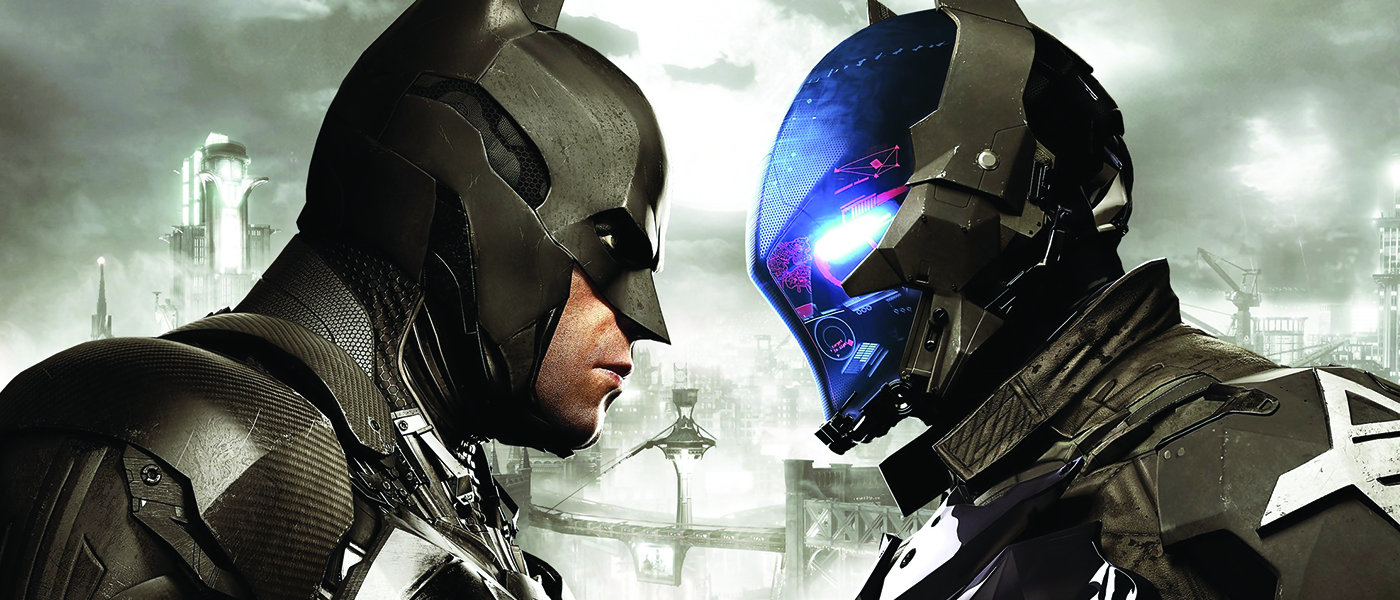*The following review was based on experiences with the PlayStation®4 version of Batman™: Arkham Knight. Technical remarks regarding stability, frame-rates and resolution may not be applicable to all platforms. Both Batman and the Arkham franchise don’t need much of an introduction at this point when we’re talking about most players, but the expectations have been high after Rocksteady’s masterful installments and even WB’s Origins prequel, but how does Arkham Knight fare in providing a closing chapter to the epic trilogy that shook the world of superhero games? Rocksteady delves even deeper into the Batman mythos as we are pulled through the closing chapter, which can partly even be seen as a greatest-hits selection of the history of the character throughout the comics.
Both Batman and the Arkham franchise don’t need much of an introduction at this point when we’re talking about most players, but the expectations have been high after Rocksteady’s masterful installments and even WB’s Origins prequel, but how does Arkham Knight fare in providing a closing chapter to the epic trilogy that shook the world of superhero games? Rocksteady delves even deeper into the Batman mythos as we are pulled through the closing chapter, which can partly even be seen as a greatest-hits selection of the history of the character throughout the comics. Arkham Knight starts of as we are introduced to Gotham City in a different way than we’re used to starting off our adventures as the caped crusader. Whilst Arkham Asylum, City and Origins all had a fairly serious tone, Arkham Knight immediately introduces itself in a more radical way. Scarecrow for instance (who was present for both Asylum and City) plays a much larger role in our main narrative, but he isn’t merely taking us into dream sequences anymore. Arkham Knight doesn’t have fear as its main theme, but insanity, which will take its toll on the characters throughout the events that are yet to come. Batman and co. are continuously subjected to defining moments that the franchise has been building up to subconsciously all this time, and the stakes really do feel high throughout our adventure through Gotham City.
Arkham Knight starts of as we are introduced to Gotham City in a different way than we’re used to starting off our adventures as the caped crusader. Whilst Arkham Asylum, City and Origins all had a fairly serious tone, Arkham Knight immediately introduces itself in a more radical way. Scarecrow for instance (who was present for both Asylum and City) plays a much larger role in our main narrative, but he isn’t merely taking us into dream sequences anymore. Arkham Knight doesn’t have fear as its main theme, but insanity, which will take its toll on the characters throughout the events that are yet to come. Batman and co. are continuously subjected to defining moments that the franchise has been building up to subconsciously all this time, and the stakes really do feel high throughout our adventure through Gotham City.
Of course Scarecrow isn’t necessarily our main attraction, and our titular antagonist Arkham Knight has taken his place at the top of the food chain to do what no other villain could ever do: kill the Batman. Seemingly he does seem to be the most competent antagonist that the franchise has taken up so far when it comes to providing a physical and psychological challenge for Batman throughout. The fight is personal for the Knight, and we’re constantly reminded of the fact, though we are left in the dark throughout the narrative when it comes to his identity and you begin to speculate who the man behind the mask really is, though the real plot twist may seem a bit lackluster for some. (Not due to the execution, but the reality behind the material that might seem more straightforward than expected, along with an arc that is left a bit more open-ended than is to be desired.) Arkham Knight has a clear main narrative, though its structure does sometimes seem to wander off in order to provide players with popular material from the comics, which is either a hit or miss when it comes to its inclusion in the main story. (When it works, it really does shine however.) In turn it does seem more focussed than its predecessors due to the fact that the main narrative focusses on a specific set of villains, giving secondary villains in the story their own mini-arcs throughout the secondary objectives of the game, which trims some of the fat that could’ve caused unnecessary filler throughout the story. As noted earlier it does delve into certain catalogue-moments with a little lack of subtlety, though in their defense they are given a solid place in the grand scheme of things as we’re headed towards the finale.
Arkham Knight has a clear main narrative, though its structure does sometimes seem to wander off in order to provide players with popular material from the comics, which is either a hit or miss when it comes to its inclusion in the main story. (When it works, it really does shine however.) In turn it does seem more focussed than its predecessors due to the fact that the main narrative focusses on a specific set of villains, giving secondary villains in the story their own mini-arcs throughout the secondary objectives of the game, which trims some of the fat that could’ve caused unnecessary filler throughout the story. As noted earlier it does delve into certain catalogue-moments with a little lack of subtlety, though in their defense they are given a solid place in the grand scheme of things as we’re headed towards the finale.
Here comes a rather problematic aspect of the ending, which may be a bigger problem for some than others. The ending of Arkham Knight is essentially split up in three sections. Players are given an ending to the main arc at the end of the story section of the game, but in order to continue the ending in its entirety they must beat a certain percentage of the secondary objectives in order to unlock the second ending, which doesn’t mark the end of the game. Playing the game to this second ending is still a joy, as you get to enjoy some of the best material you may have missed, but the secondary ending itself provides an issue. The structure of the second and third ending is identical, though the former is cut off at a rather out-of-place section, leaving most of the substance (which is pretty essential, rather than a nice easter egg) to the third ending, which can only be showcased after completing the game for a 100%, including all Riddler riddles. Even though the material you get to play is nothing short of great to awesome, the main issue is that players who aren’t interested in the secondary objectives may be left in the cold with an ending that is as incomplete as it is underwhelming. From a design perspective it is an understandable design choice, but it may be quite frustrating for some, especially if you don’t even realize you’re not at the end as is. The Arkham franchise is yet another one that is making its first debut on current gen hardware, but also marking the return of its original development team. How well does Batman: Arkham Knight fare when it comes to providing an engaging visual experience? The game isn’t a 100% perfect in all aspects, but that really isn’t saying much as you set your first steps into Gotham as the caped crusader, who himself has also never looked better when it comes to graphical fidelity. Not only has the franchise taken a notable jump when it comes to scale, but in terms of design and clarity the difference is knight and day (I hate myself already for that pun, so don’t worry.)
The Arkham franchise is yet another one that is making its first debut on current gen hardware, but also marking the return of its original development team. How well does Batman: Arkham Knight fare when it comes to providing an engaging visual experience? The game isn’t a 100% perfect in all aspects, but that really isn’t saying much as you set your first steps into Gotham as the caped crusader, who himself has also never looked better when it comes to graphical fidelity. Not only has the franchise taken a notable jump when it comes to scale, but in terms of design and clarity the difference is knight and day (I hate myself already for that pun, so don’t worry.)
Rather than having the game built on the newest version of the Unreal Engine it runs on a heavily modified version of Unreal Engine 3, which Rocksteady had been working on throughout the production process of the franchise. From a technical perspective it’s hard to say wether the game would perform better on newer software, but Arkham Knight looks and plays as next-gen as it gets. The game isn’t the first open-world game we’ve been introduced to throughout this generation, but it may be one of the moodiest and deep worlds that’s been showcased in the genre. Whilst games like The Witcher and such take their crown in providing luscious open worlds of nature and such, Arkham Knight preforms the feat of showcasing and urban and moody setting that is as much of a character as its protagonist in a way. The only remark that I can make here is that it does seem a little too light on civilian activity, but this is explained by the plot. The city has been modelled to great detail, with crisp and clear characters to finish to ensemble. The entire world is presented in a dark but vivid manner as the lighting engine and design compliment the layout of Gotham City, wether it be the street lights of a dark alley or the bright and colorful neon-signs that grace the rooftops of Gotham. Destruction is also present to a certain degree, as certain aspects of the open world are destructible to the sheer violence the Batmobile may cause. (A little fun fact, I may have caused more damage than Arkham Knight and Scarecrow ever did throughout the game.)
The city has been modelled to great detail, with crisp and clear characters to finish to ensemble. The entire world is presented in a dark but vivid manner as the lighting engine and design compliment the layout of Gotham City, wether it be the street lights of a dark alley or the bright and colorful neon-signs that grace the rooftops of Gotham. Destruction is also present to a certain degree, as certain aspects of the open world are destructible to the sheer violence the Batmobile may cause. (A little fun fact, I may have caused more damage than Arkham Knight and Scarecrow ever did throughout the game.)
Performance-wise the game runs at a solid 30 frames per second, though the engine is somewhat tested at times when there’s a lot going on at the same time. These dips usually take place during Batmobile sequences, especially when there’s a notable amount of destruction and/or particle effects being showcased on screen at once. In the grand scheme of things these dips seemed to be a minor hinderance though, as in over 12 hours these dips may have only covered a few minutes of gameplay in total, providing a very smooth experience overall, which is quite a feat when you look at some of the on-screen action. In the case of the PlayStation®4 version the game is showcased at a resolution of 1080p, which delivers a clear and visually pleasing presentation. Additional filters such as film grain are present, though it doesn’t seem to interfere with the visual presentation to a problematic level, and depending on your likings it may add a nice cinematic touch. Batman: Arkham Knight takes a lot from the previous installments when it comes to gameplay, though it adds its own fair share of gameplay elements that are either enhancing the former or providing completely new elements to the franchise. The basis of combat is quite similar, and may play identical for many, but the refinements in both animations and arsenal create a system that is as visually pleasing as it is to master. The FreeFlow combat system is still a matter of reflexes in many ways, but taking your time to learn all the combinations and techniques is a fun and quite strategic element that really does satisfy when used properly. The combinations with the expanded arsenal of gadgets make it clear that the Arkham franchise is still one of the strongest contenders in the genre when it comes to providing a deep but easy-to-use combat system.
Batman: Arkham Knight takes a lot from the previous installments when it comes to gameplay, though it adds its own fair share of gameplay elements that are either enhancing the former or providing completely new elements to the franchise. The basis of combat is quite similar, and may play identical for many, but the refinements in both animations and arsenal create a system that is as visually pleasing as it is to master. The FreeFlow combat system is still a matter of reflexes in many ways, but taking your time to learn all the combinations and techniques is a fun and quite strategic element that really does satisfy when used properly. The combinations with the expanded arsenal of gadgets make it clear that the Arkham franchise is still one of the strongest contenders in the genre when it comes to providing a deep but easy-to-use combat system.
Traversal has undergone similar changes, but this is also largely influenced by the fact that there’s a little not-so-small addition to our arsenal of toys: the Batmobile. The Batmobile in Arkham Knight isn’t simply a means of transportation as it is more of an extension of his arsenal of gadgets, albeit a bit too large to fit on his belt (god knows what else he’s got in that belt though.) The Batmobile is used in many ways, ranging from combat to puzzles and advanced traversal, providing a much needed addition when it comes to providing gameplay variety to the franchise. Combat, traversal and such are a joy to endure thanks to the great gameplay design and handling, but the sheer amount of emphasis on its contents does create another problem. Whilst it creates a lot of much-need variety it also takes some of it away due to the fact that the amount of content based around it is simply staggering sometimes. Ranging from long sections of the campaign to the secondary objectives, though to be fair most of it is well-designed. The main story gives players about 8 to 12 hours of content to play around with, depending on how players wish to spend their time in between missions. Players are free to go through the story as fast as possible (most of the time), but they can also take intervals saving the city from the hands of its enemies. Most of the secondary objectives are similar in set-up to the campaign itself, though each series of objectives provides its own short story arc, which has players complete them in order to add each accompanied villain to the line-up at the GCPD police station. After each series of events the player has to bring each captured major enemy to the station using the Batmobile, at which the rogues gallery behind bars. This isn’t without reward, as everything helps you work towards the satisfying finale.
The main story gives players about 8 to 12 hours of content to play around with, depending on how players wish to spend their time in between missions. Players are free to go through the story as fast as possible (most of the time), but they can also take intervals saving the city from the hands of its enemies. Most of the secondary objectives are similar in set-up to the campaign itself, though each series of objectives provides its own short story arc, which has players complete them in order to add each accompanied villain to the line-up at the GCPD police station. After each series of events the player has to bring each captured major enemy to the station using the Batmobile, at which the rogues gallery behind bars. This isn’t without reward, as everything helps you work towards the satisfying finale.
The issue that can be found with some of the secondary objectives are those that are easily identifiable with most open world games, which is variety. This issue is only as great as the player can make it however, as the game does effectively encourage you to switch objectives as you go. Not only is there an easy menu that will help you choose what you want to do throughout, but there are also visual cues on your rader that will give you a notice towards previously undiscovered missions, which may lead you to divert from your previously set path. The game is optimally played by diversifying your activities by finding a balance between the main story and the secondary objectives. This doesn’t just give you a fuller experience but it also helps you gain upgrade points for combat, gadgets and the Batmobile, which are heavily needed as you progress throughout the game’s narrative. Saving everything for the endgame can lead to frustration in the long run, as the similarity of missions in the same series can lead to repetitiveness when played through in succesion. This is as much of a knock to gameplay design as it is to player styles, as it leans towards changing many of our habits concerning secondary objectives, whilst providing a somewhat more tedious experience for players who want to save everything for last (which I don’t advise.) Ending a trilogy in the videogame industry can be as tedious as it is in filmmaking, but Rocksteady has managed to deliver a narratively comprehensive and engaging experience that is accessible to both returning and new players. Experiences may vary when it comes to variety in gameplay, but ultimately Batman: Arkham Knight succeeds in what every superhero game wants to do: make us feel like we’re actually the hero in question. This may be the last we’ll see of Rocksteady and Batman in a while, but if anything they’ve managed to go out with a bang, which is already quite a feat by itself.
Ending a trilogy in the videogame industry can be as tedious as it is in filmmaking, but Rocksteady has managed to deliver a narratively comprehensive and engaging experience that is accessible to both returning and new players. Experiences may vary when it comes to variety in gameplay, but ultimately Batman: Arkham Knight succeeds in what every superhero game wants to do: make us feel like we’re actually the hero in question. This may be the last we’ll see of Rocksteady and Batman in a while, but if anything they’ve managed to go out with a bang, which is already quite a feat by itself.



